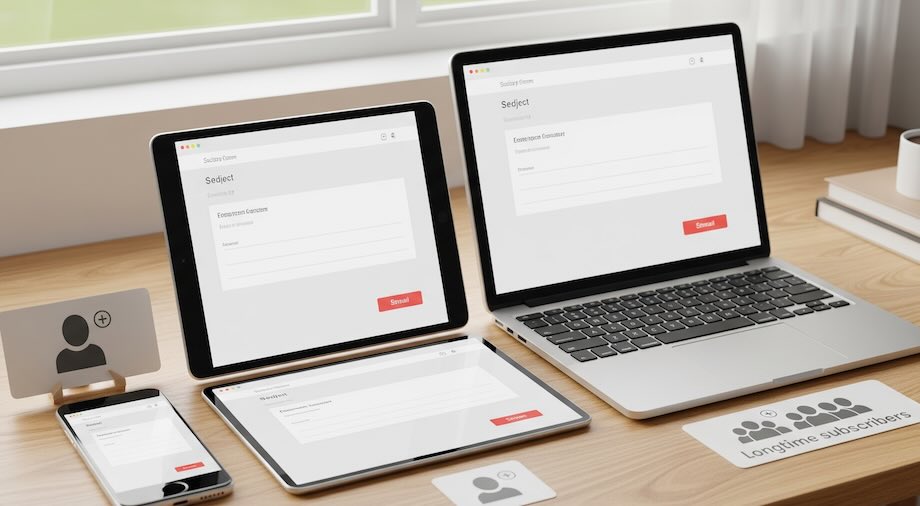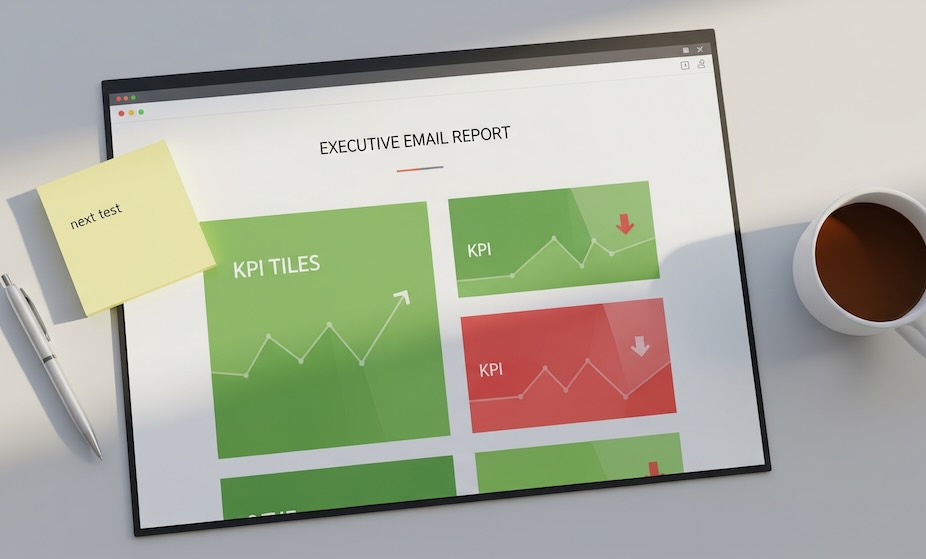You don’t need a data team to get smarter about email. A handful of simple metrics—understood the right way—can tell you whether your messages are reaching people, getting attention, and motivating action. This guide explains the core numbers (no tooling or setup required) and how to interpret them so your next send performs better than your last.
The three questions email metrics answer
- Did it arrive? (deliverability) – see the email sender guidelines for what mailbox providers expect.
- Did it earn attention? (opens and engagement with the message itself)
- Did it create action? (clicks and downstream behavior)
Keep those in mind as you read the numbers; each metric lives under one of these questions.
Core metrics, plain English

Delivered
- What it is: Messages accepted by recipients’ mail servers.
- Why it matters: Everything else is downstream of delivery. If delivery is poor, fix that first (list quality, sender reputation, expectations), not design. For large consumer inboxes Yahoo’s sender requirements.
Open rate (with caveats)
- Definition: Unique opens ÷ delivered emails.
- What it shows: Subject line relevance, sender trust, and timing.
- Caveat: Privacy features (e.g., Apple’s Mail Privacy Protection) can inflate opens by preloading images. Treat open rate as a trend, not a precise truth. When in doubt, pair it with click-to-open rate.
Click-through rate (CTR)
- Definition: Unique clicks ÷ delivered emails.
- What it shows: Overall campaign effectiveness at generating traffic. It blends “did they open?” and “did they click?” into one outcome number.
Click-to-open rate (CTOR)
- Definition: Unique clicks ÷ unique opens.
- What it shows: Email content performance once someone has opened. If CTOR is weak, your body copy, layout, or call-to-action likely missed the mark—even if the subject line worked.
Unsubscribe rate
- Definition: Unsubscribes ÷ delivered emails.
- What it shows: Relevance over time. Spikes signal misaligned expectations, list fatigue, or too-frequent sends. Remember: recipients have this right under the CAN-SPAM Act, and major inboxes require easy one-click unsubscribes.
Complaint rate (spam reports)
- Definition: Spam complaints ÷ delivered emails.
- What it shows: Permission problems or a trust break (surprising content, confusing sender identity). Even tiny increases matter because mailbox providers weigh this heavily monitor via Postmaster Tools and stay under Gmail’s reported spam threshold.
Bounce rate
- Hard bounces: Permanent failures (fake/expired addresses).
- Soft bounces: Temporary issues (full mailbox, server hiccup).
- Why it matters: Persistently high bounces drag down sender reputation and, eventually, delivery. Technically, SMTP uses 5xx codes for permanent errors (hard) and 4xx for transient (soft).
Quick formulas
- Open rate = unique opens / delivered
- CTR = unique clicks / delivered
- CTOR = unique clicks / unique opens
- Unsubscribe rate = unsubscribes / delivered
- Net list growth = (new subscribers − unsubscribes − spam complaints − hard bounces) / starting list size
Absolute “good” numbers vary wildly by audience and industry. What matters most is your baseline and how each send performs relative to that baseline.
Reading the story in your metrics
Use these patterns to diagnose what happened without touching any settings.
High opens, low CTOR
- Story: The subject line was compelling, but the content didn’t deliver the promised value or the CTA was unclear.
- Adjust next time: Tighten the message-to-offer match. Make one primary CTA unmistakable.
Low opens, healthy CTOR
- Story: The people who saw the email liked it, but not enough people opened.
- Adjust next time: Revisit sender name, subject clarity, preview text, and send cadence before changing content.
Stable opens, rising unsubscribes
- Story: The audience is paying attention but losing patience.
- Adjust next time: Reduce frequency for segments showing fatigue, set clearer expectations in your copy, and ensure every email earns its place.
CTR drops while CTOR holds steady
- Story: Fewer people are opening (top-of-email problem) rather than content quality.
- Adjust next time: Work on the open drivers (subject, timing, recognizability).
Complaint rate ticks up
- Story: A trust break—surprising or off-topic content, unclear sender identity, or permission issues.
- Adjust next time: Reaffirm value in the header, align content with what subscribers asked for, and avoid bait-style subjects. Keep an eye on Postmaster Tools dashboards for reputation and spam-rate signals.
Segment views that make numbers meaningful
You’ll learn more by slicing results than staring at totals.
- New vs. longtime subscribers: Newcomers judge you on onboarding relevance; veterans judge consistency. If new-subscriber unsubscribes outpace the average, your early content isn’t matching expectations.
- Campaign type: Educational vs. promotional vs. product update. Each has a different “normal.” Compare like with like.
- Device: Mobile readers decide fast. If mobile CTOR lags with healthy opens, your layout likely buries the primary action.
- Acquisition source: Subscribers from gated content behave differently than those who opted in during checkout or a webinar. Evaluate performance by source quality.

What each metric implies you should improve
- Open rate: Promise and timing. Reassure with a consistent sender name, make the value obvious in subject and preview, and avoid curiosity that the content can’t cash.
- CTOR: Message clarity and scannability. If people open and stall, reduce clutter, elevate one CTA, and lead with outcomes over features.
- CTR: Overall fit. When CTR sinks, ask “Was this email worth sending to this audience today?”
- Unsubscribes/complaints: Expectation management. The email should remind subscribers why they’re on the list and what they’ll gain right now.

Benchmarks vs. baselines: which should you trust?
Public benchmarks can be useful for directional context, but they’re noisy. Your best yardstick is a 6–8-send baseline by campaign type. Use that to judge whether a new idea helped or hurt. If you must compare externally, ensure the audience, content type, and region are similar; otherwise, you’ll chase ghosts.
Simple report your stakeholders will actually read
Keep it to one page, per campaign type:
- Outcome summary: CTR, CTOR, unsub rate vs. 6-send baseline (green/up, red/down).
- Top insight: One sentence: “Open rate up + CTOR down = subject promise stronger than content; next send will front-load the offer.”
- Audience note: Biggest segment shift (e.g., “New subscribers CTOR +3 pts; loyal audience flat”).
- Next test: One focused change to learn from (“Shorten preheader to emphasize benefit; keep content constant”).
This keeps the conversation on insight and learning, not tooling.

Common pitfalls to avoid
- Chasing opens alone: An inflated open rate doesn’t mean your email worked. CTOR and CTR tell you whether attention turned into action.
- Too many links: Multiple equal CTAs confuse readers and dilute clicks. Pick a primary action and support it.
- Subject bait-and-switch: You may earn opens today but pay with unsubscribes tomorrow. Promise only what the body keeps.
- Ignoring negative signals: Unsubscribes and complaints are feedback. If they rise, the list is telling you something—listen.
A tiny glossary (so everyone’s aligned)
- Unique vs. total: Unique counts each person once; total counts every open/click. For judgment, prefer unique.
- Preheader (preview text): The snippet next to the subject line; it’s free real estate to reinforce value.
- Primary CTA: The one action you’d be thrilled for readers to take; everything else is optional.
Bottom line
You don’t need dashboards full of dials. Start with delivered, opens, clicks (CTR/CTOR), unsubscribes, and complaints; look at them by campaign type and audience segment; judge them against your own baseline. The pattern those numbers form is the real story of your email program—and the simplest path to better results next time.
